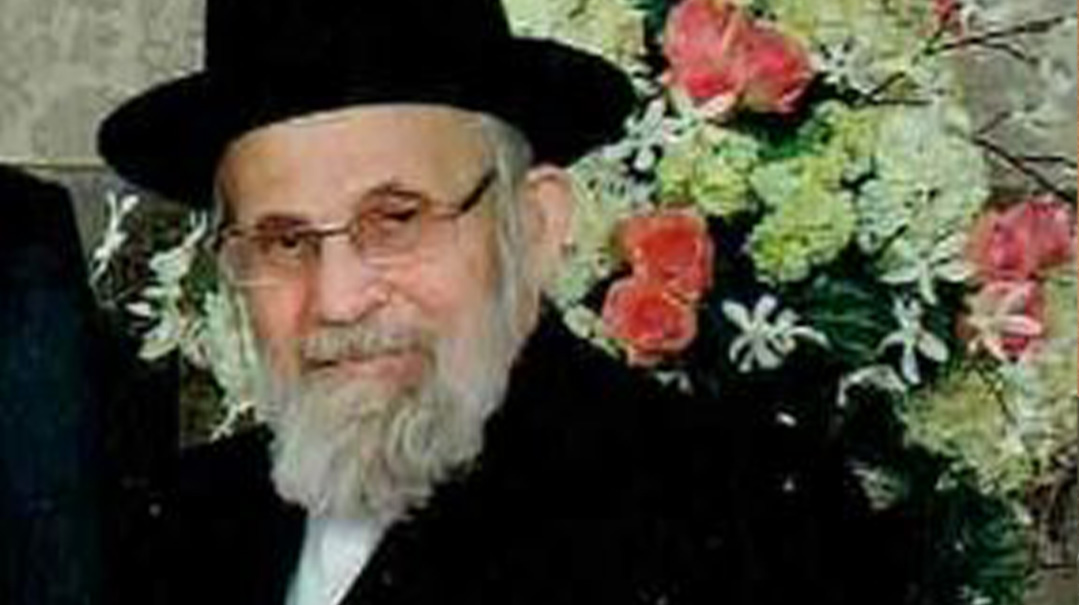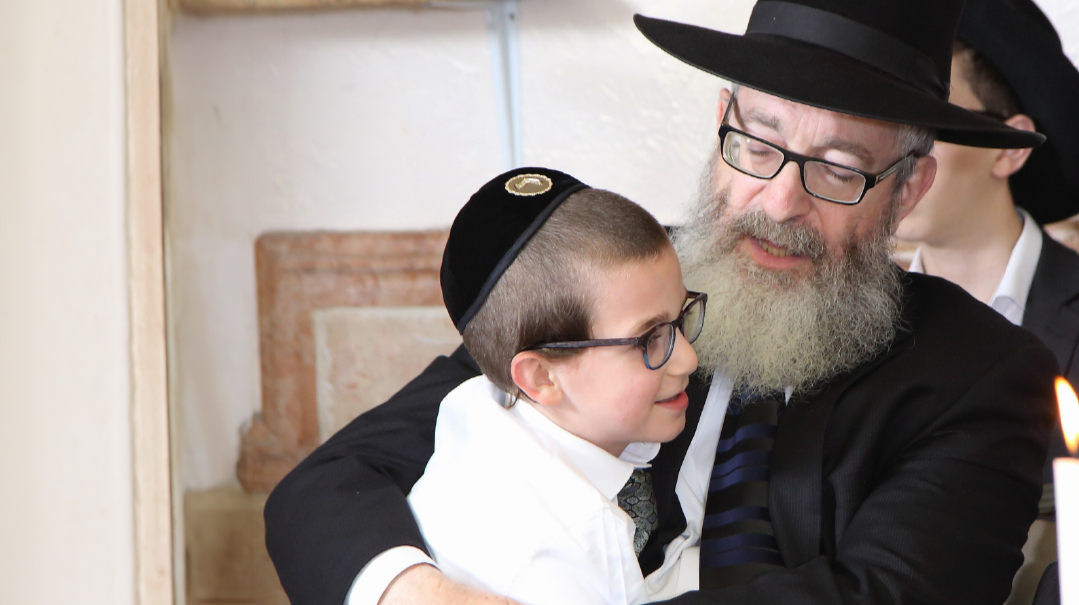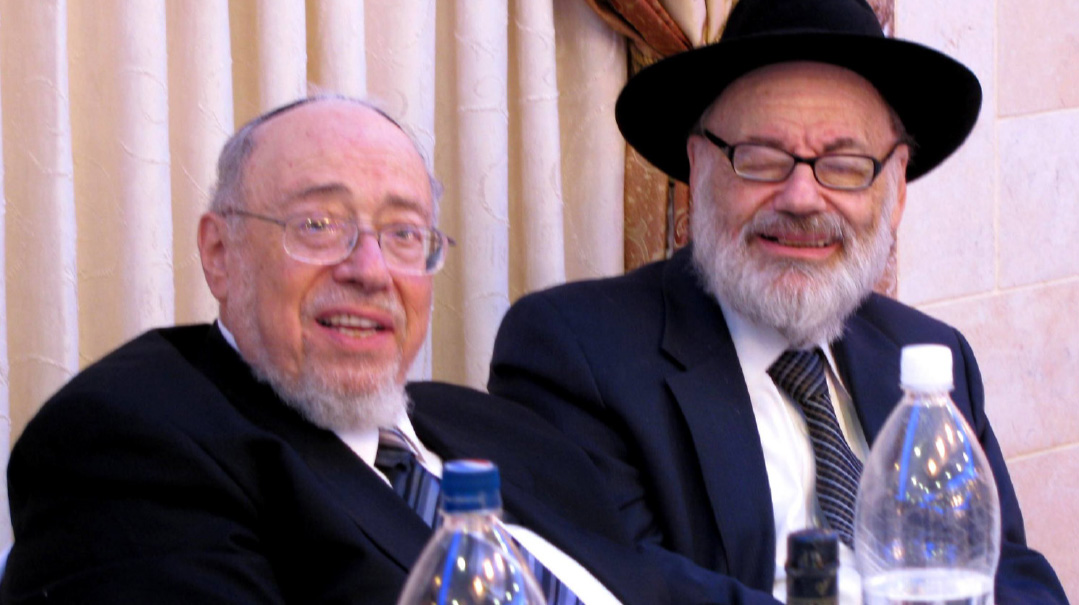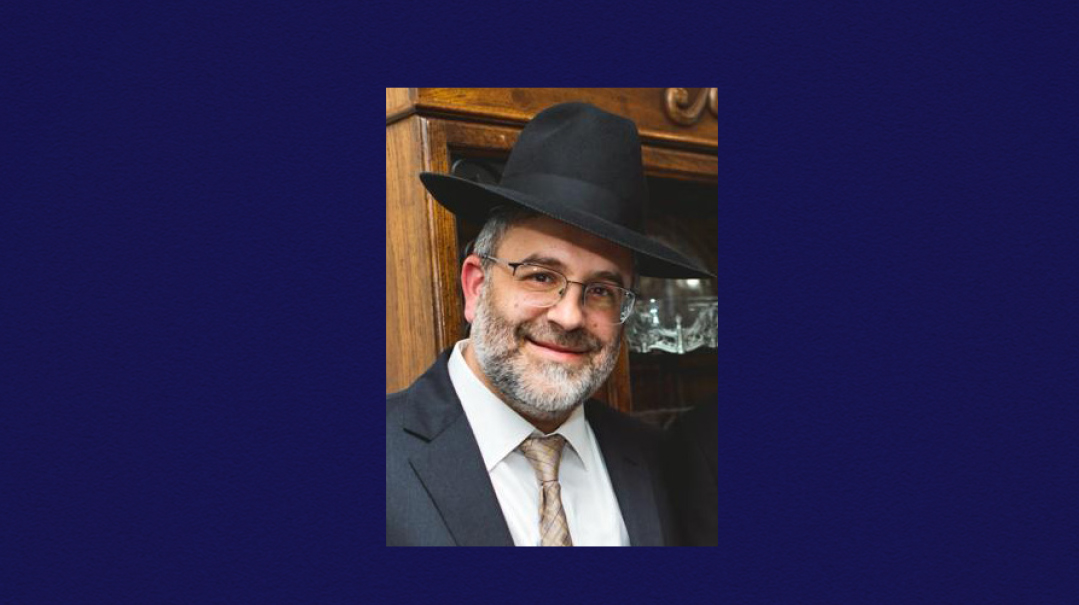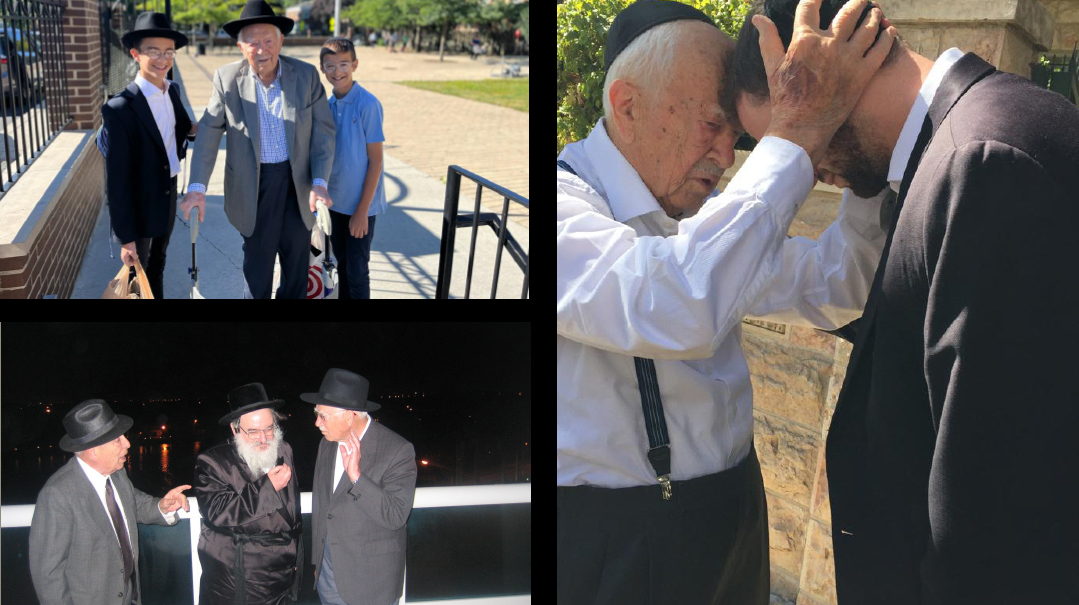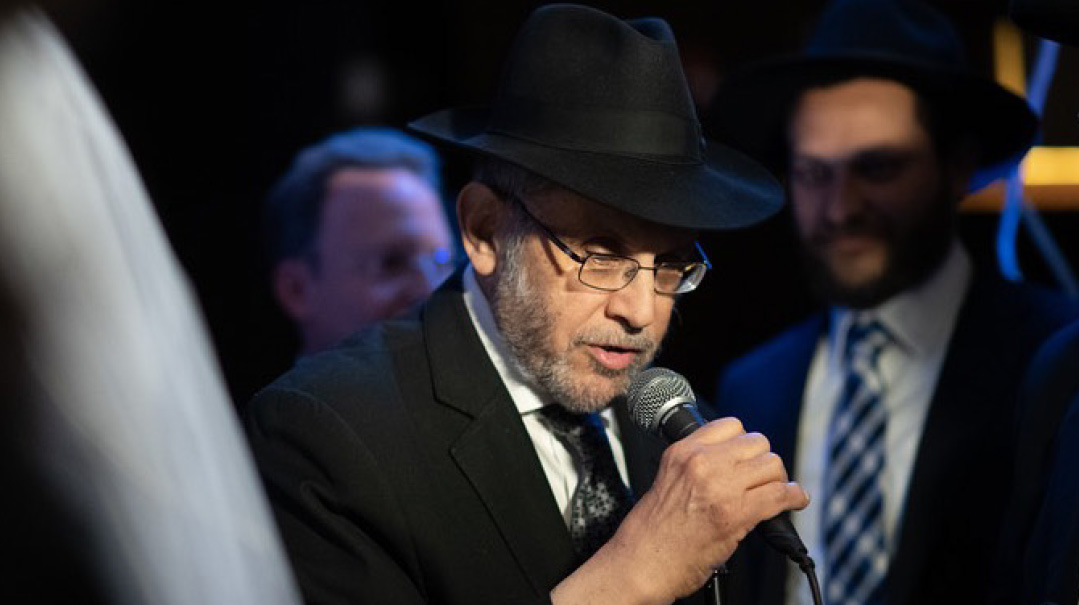The Path to a Bochur’s Heart
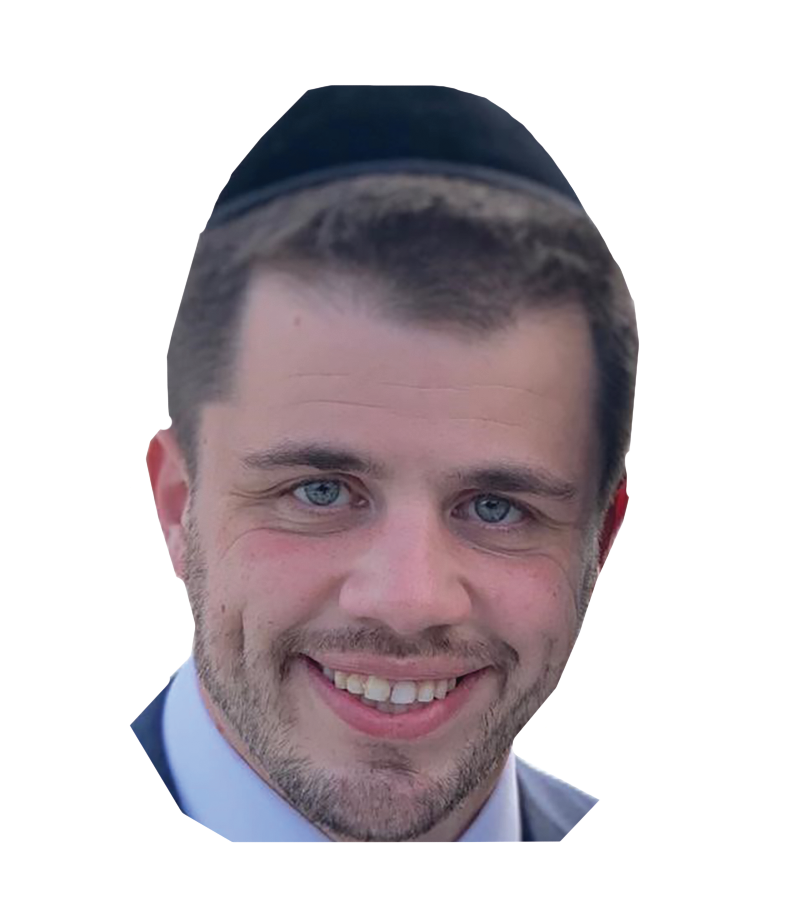
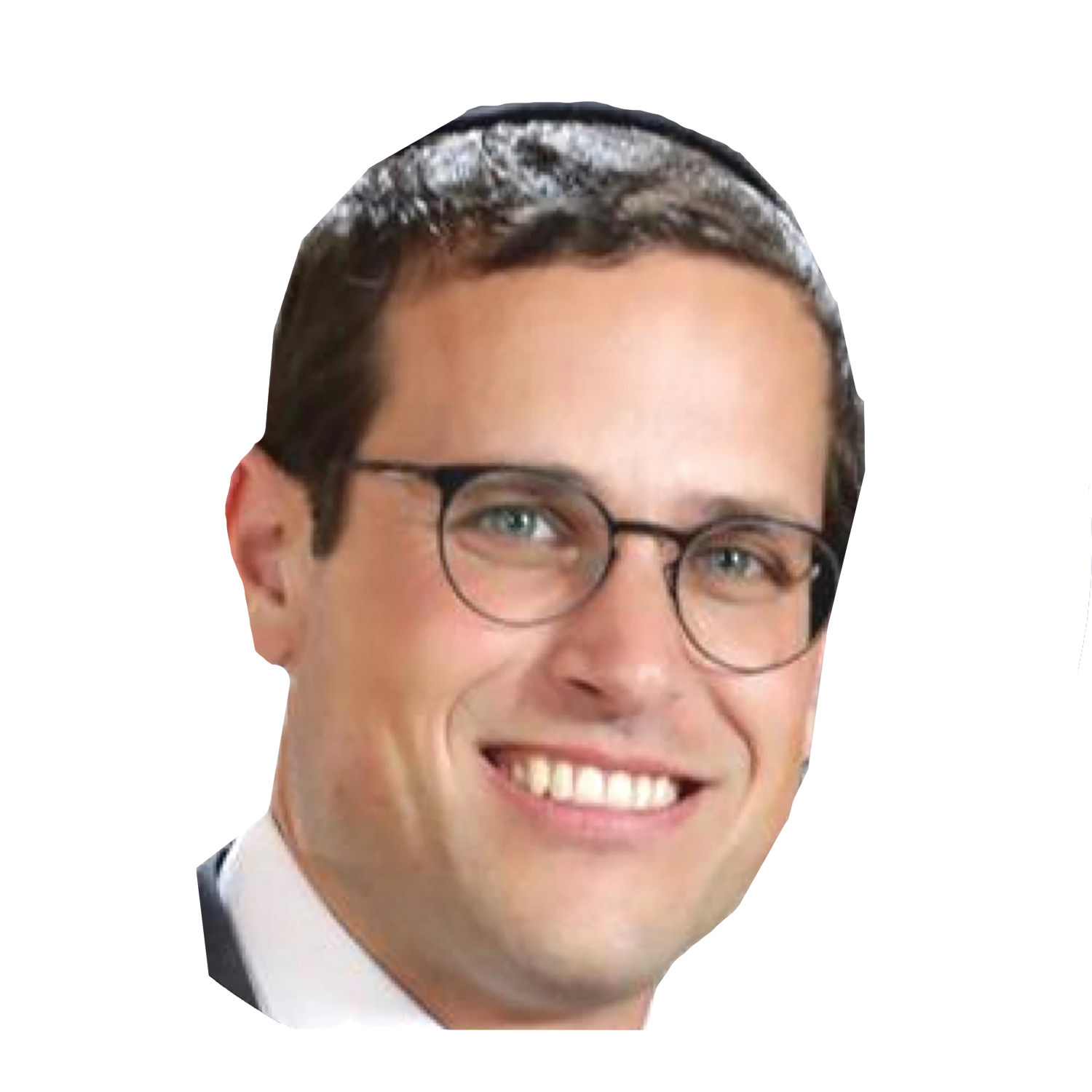
Rav Aharon Chodosh embodied the spirit of Slabodka, yet he was a mashgiach for a new generation. His passing last week marks the end of an era – a great rav schooled in the historic yeshivah tradition who understood the soul of his American boys
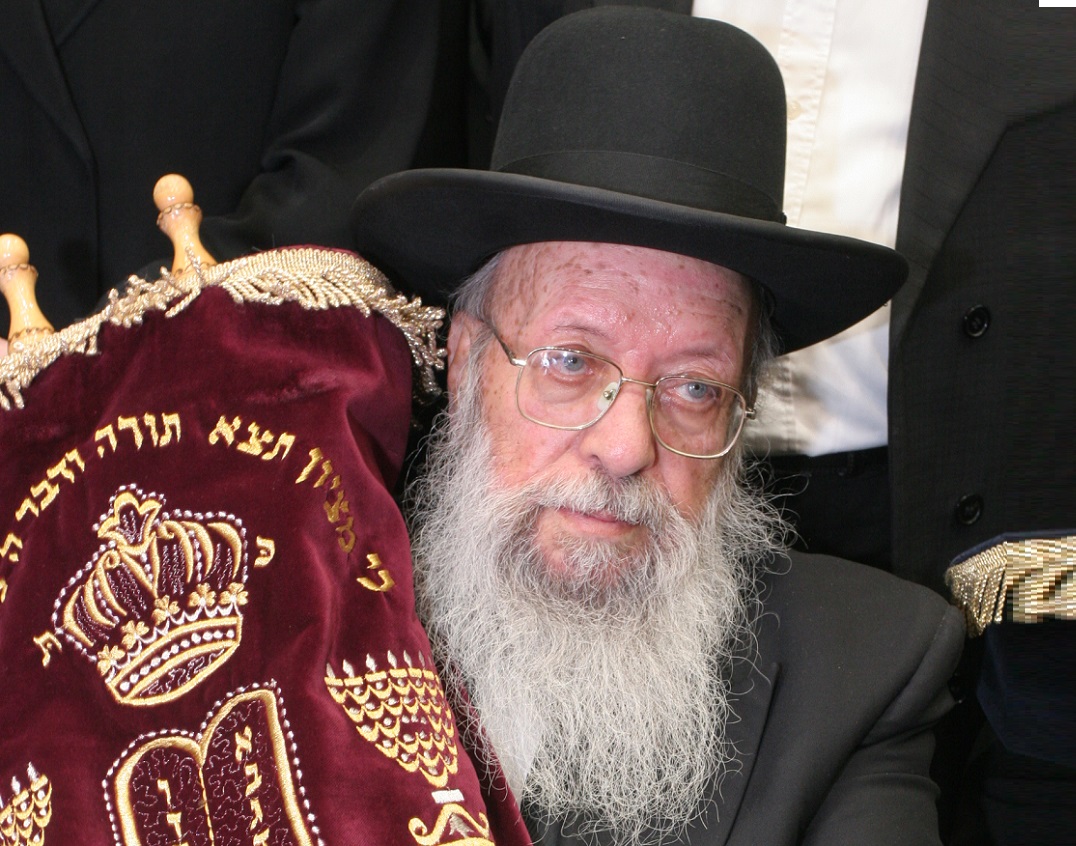
Photos: Mattis Goldberg, Personal archives, Mir archives, Uri Stern
The words “Mir Mashgiach” are enough to make one tremble in reverence.
Rav Yerucham Levovitz, Rav Chatzkel Levenstein, Rav Chaim Zev Finkel — the giants of mussar who filled the post in the past — moved mountains and built men. Our generation had its own mashgiach. For more than half a century, Rav Aharon Chodosh was “the Mashgiach” to tens of thousands of talmidim. He imbued us with the spirit of Slabodka and the Torah of Mir. But most of all, he built people. He saw the latent capabilities of every talmid and inspired them to achieve their potential.
The last time we were zocheh to spend significant time together with the Mashgiach was during the Mir Yarchei Kallah last November. Typically, we would show up without any formal invitation, and always, a short Torah thought would lead to a long schmooze, complete with an evocative mussar lesson, vort on the parshah, or fascinating historical reminiscences.
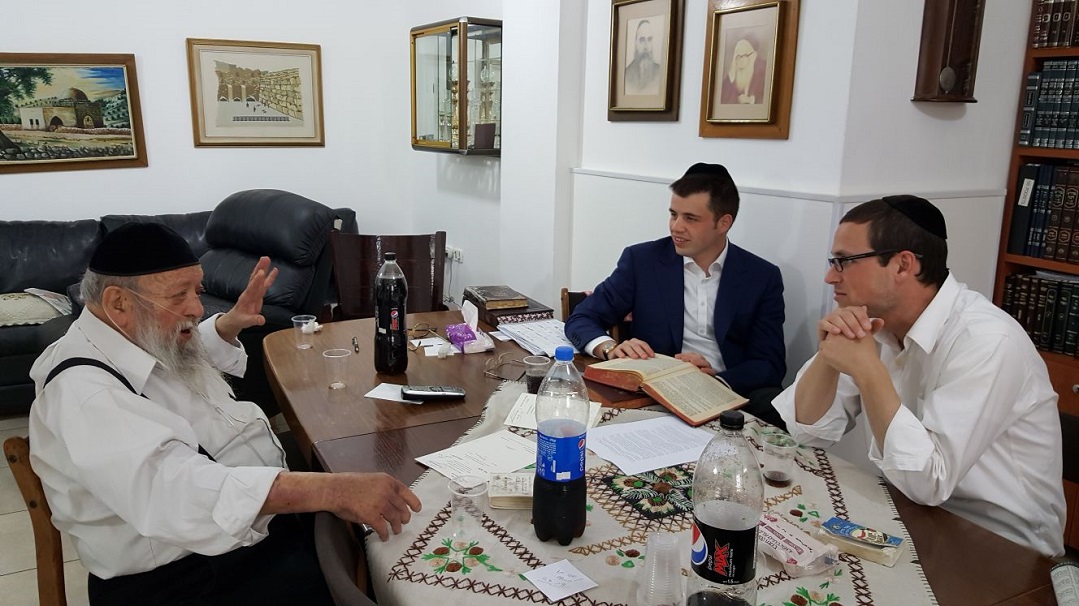
The outpouring of grief and memories from so many others upon Rav Aharon’s passing last week at age 91 confirmed what we had long intuited, and what Rav Binyamin Finkel — his nephew and successor — voiced in his hesped: “What made the Mashgiach unique was that his words of mussar focused equally on ruchniyus and gashmiyus. He’d give tochachah to family and talmidim with regard to their Torah learning and their eating habits in an equal fashion. Because it was so obvious that he cared for a talmid’s physical needs along with his spiritual ones, the recipient felt his love and would accept his mussar.”
A Contract Signed in Blood
Rav Aharon would often relate the story of his mother, Tzivia Leah Hutner, who traveled alone from her childhood home in Eishyshok to Chevron of the 1920s. There she lived in the home of her uncle, the Slabodka Rosh Yeshivah, Rav Moshe Mordechai Epstein. She eventually married one of the Alter of Slabodka’s finest talmidim, Meir Chodosh, who would go on to be his spiritual heir as the longtime mashgiach of the Chevron Yeshivah.
At the time of the savage 1929 massacre, the young Chodosh couple were expecting their first child. After they were miraculously saved and blessed with a healthy son, they decided to name him after one of the martyred students, Aharon Dovid Epstein — a nephew of the Rosh Yeshivah and cousin of Rebbetzin Chodosh. This Chicago boy had made the ultimate sacrifice to study Torah in Eretz Yisrael.
The future mashgiach’s name would forever tie him to his destiny: total devotion to the cause of Torah and chinuch, as well as an appreciation for the talmidim who arrived from overseas to study Torah in Eretz Yisrael.
In his later years, the Mashgiach suffered from many physical ailments. Every time he would return from the hospital and to his normal yeshivah schedule, it seemed miraculous. With inner reserves of strength and fortitude, he seemed to defy death itself. Then again, that persistence seemed to have been his hallmark since his birth.
When the Mashgiach was still a toddler, his mother brought him and his younger sister (today Rebbetzin Shulamis, wife of Rav Baruch Mordechai Ezrachi) to visit her family back in Europe. Around Shavuos time, his mother, with young Aharon Dovid in tow, went to nearby Radin to seek a brachah from the Chofetz Chaim. The Mashgiach would later attribute his arichus yamim to that brachah.
Prior to Rebbetzin Chodosh’s return to Eretz Yisrael, her husband was offered a prestigious rabbinical offer in Poland. Referring to her survival in the Chevron pogrom three years earlier, she declared, “My connection to Eretz Yisrael is a contract signed in blood!” No offer could entice her to leave the Holy Land.
Until his marriage, Rav Aharon attended the Chevron Yeshivah in Jerusalem, where Rav Chatzkel Sarna was rosh yeshivah and his father and primary rebbi, Rav Meir Chodosh, was mashgiach. Though his Chevron roots were strong, his marriage to Rebbetzin Chasida Finkel a”h, daughter of the Mir mashgiach Rav Chaim Zev Finkel, eternally cemented his name to the Mir Yeshivah. It was a shidduch reminiscent of one that had occurred a half-century earlier, when the Alter of Slabodka’s son Eliezer Yehuda had married Malka, the daughter of the Mir rosh yeshivah, Rav Elya Boruch Kamai, thus cementing the Mir as a “mussar style” yeshivah for posterity.
New Vision for the Mir
As a freshly married yungerman and newcomer to the then-small institution, Rav Aharon energetically sought to improve the Mir Yeshivah. His efforts did not go unnoticed. “Vayakam melech chodosh,” the veteran Yerushalmim in the yeshivah would quip, cleverly referencing both his last name and new influence.
With his father-in-law’s passing in 1965, Rav Aharon slowly assumed the post of mashgiach, a position he would maintain for 55 years. Though he was asked to deliver schmuessen, he refused this formal, established role, stating that he preferred to educate and inspire the talmidim in other ways. That was just one hint that this new mashgiach was unlike any of his predecessors. With the passing years, it grew apparent that Rav Aharon possessed a keen understanding of both the ideal tzuras hayeshivah as well as the needs of the talmidim. With foresight, persistence, and zero concern for what others might say or think, he embarked on a rigorous reform of the yeshivah structure.
Until his tenure, Yeshivas Mir Yerushalayim was primarily a kollel for married students. Recognizing the need for an injection of fresh young talent, he restructured the yeshivah so that its primary focus was on non-married talmidim.
Rav Nochum Partzovitz’s shiur filled with top students from Eretz Yisrael, and soon the vanguard began to arrive from the United States as well. Rav Nochum would later state, “Rav Aharon built the Mir. We had Rav Leizer Yudel [Finkel], Rav Chaim Shmuelevitz, and myself, and we weren’t able to do it. Rav Aharon built the Mir in Eretz Yisrael.”
The cornerstone of his policy was simple but revolutionary. When Yehuda Geberer was serving as yeshivah gabbai — a post the mashgiach would only allow an unmarried talmid to fill — Rav Aharon would tell him to distribute aliyos primarily to bochurim, and repeat countless times, “The yeshivah belongs to the bochurim.” He believed that the vitality of the entire institution stemmed from the bochurim who live in or near the yeshivah and are constantly there filling the beis medrash with a kol Torah.
In the mid 1990s, the Mashgiach asked a student with a more heimishe background why he didn’t daven in yeshivah on Friday night. When the young man explained that he and his friends preferred a Shabbos davening in which Lecha Dodi is sung, the Mashgiach didn’t skip a beat. “You’re going to be the chazzan this coming Friday night in the yeshivah beis medrash, and you’re going to bring all your friends as well. You’re welcome to sing all you like.” Without consulting with other hanhalah members about this breach in a hallowed litvish tradition, the Mashgiach took the initiative; he felt that having the bochurim daven in yeshivah superseded accepted norms.
Like a Father
The Rosh Yeshivah, Rav Nosson Tzvi Finkel ztz”l, had the utmost respect and trust in the Mashgiach when it came to assessing a talmid’s needs. When the open-door policy in the Mir was in its heyday, Rav Nosson Tzvi would sign the acceptance notes with the word “hiskabel” (accepted). The bearer of the note would then proceed to the Mashgiach for the formal acceptance and registration. Oftentimes Rav Nosson Tzvi was unsure about the potential of a prospective talmid, and he’d sign the note with “kefi re’os einecha” (as you see fit), trusting Rav Aharon’s ability to perceive the level and potential of every new arrival.
With the Mashgiach getting on in years and the stream of new applicants rising, we were often part of a small group of bochurim privileged to assist him at times with translation and paperwork, sitting next to him in his office as each new bochur stepped in. We witnessed firsthand how he studied each new talmid intently, never asking uniform questions but rather tailoring them based on his instant assessment of the individual standing before him, calming the nervous ones and putting in place the overconfident ones.
He’d calm one nervous bochur down by playing Jewish Geography (isn’t your grandfather so and so? I knew him very well), and ask another about which dirah he planned to join. “Almost the entire hatzlachah of a talmid in Mir Yeshivah is dependent on who his shecheinim (dirah mates) are,” he’d often emphasize. On many occasions he’d advise new arrivals how to be successful in a large yeshivah, which was unlike the smaller environment from where they had come. “In Mir,” he’d say, “ you must learn to be like the chassidim — push to get ahead. But don’t push others!”
Perhaps the most unique aspect of Rav Aharon, and what set him apart as an educator, was his fatherly approach to the role of mashgiach. One spoke to him as to a grandfather or even a friend. He had no airs about him and was completely unpretentious. He’d make you feel so comfortable approaching him that you almost forgot that he was the mashgiach of the great Mir Yeshivah.
A talmid recalls his first meeting with the Mashgiach:
My first encounter with Rav Aharon left an indelible impression on me. I was a 20-year-old bochur from Chicago, and before I could even say my name he put his finger on my shirt lapel and said, “Sonofsky’s?” This was a closeout store in Chicago that sold shirts for cheap prices. I was blown away. (I subsequently found out that he had a talmid who purchased shirts for him there.)
This set the tone for what was to be a fruitful relationship. On the one hand he was the mashgiach, but at the same time he knew just the right thing to make you feel comfortable.
Rav Aharon’s seat of choice for davening was in the middle of the beis medrash — both because it was unassuming and because it allowed him closer contact with the talmidim. He saw davening in yeshivah as the highest priority. In a practical sense, it was the only way for a bochur to merit a room in the dormitory, but in an educational sense he truly believed that it was the most effective tool for a talmid’s growth.
Following davening every morning, there was usually a huddle around the Mashgiach’s seat. This one wanted to discuss his likelihood of getting into the dorm, that yungerman asked him for a loan (he maintained a gemach for decades, keeping all the records by hand and sustaining hundreds of kollel families), another bochur who had some important matter to discuss, yet another asking him to explain a perplexing passage of davening.
Reb Shlomo Yehuda Rechnitz still remembers joining the Mir at just 17 years old, and finding an unlikely supporter in Rav Aharon, who invested time and effort so he would succeed in learning. Eventually, he felt his time there was done, and so he packed his bags and made plans to move on to a different yeshivah.
Then, over bein hazmanim, he was informed that he hadn’t been accepted.
He wasn’t sure what his next step would be, but of one thing he was sure: There was no way he could return to the Mir. After a very public goodbye party, it would be terribly humiliating to return — everyone would realize that he had been rejected. The logical next step seemed to be entering the business world.
Then his father told him, “If you stay here in Los Angeles, you’ll be handing a victory to that rosh yeshivah who refused to accept you. Your biggest revenge would be to go back to the Mir and learn with hasmadah.”
So he packed his bags and returned to Beis Yisrael. Standing outside the beis medrash, though, he lost his nerve. He just couldn’t step inside. Finally, he walked in. It was excruciating to imagine all those eyes scrutinizing him, judging him.
Then, suddenly, someone started laughing. Shlomo Yehuda looked up and saw Rav Aharon Chodosh, watching him and laughing. What was happening?
Rav Aharon approached him and said, “Look at the power of tefillah! I davened and davened that you should come back to us, and — look! You’re here!”
With one powerful line, the Mashgiach had made it clear: Your place is in the Mir.
Bond for Life
Life in the Mir features no shortage of joyous occasions: siyumim, l’chayims, seudos preidah, and the like. They take place in dirahs, shiur rooms, or any other venue that can be commandeered for the purpose. The Mashgiach would make it his business to attend these whenever possible. He would participate in the festivities and generally deliver some short remarks.
At the seudas preidah for a popular friend of ours he got up and stated, “In the future, we’ll refer to the last two years as the years that Moishy was here in Mir Yeshivah.” That talmid practically floated to the airport and has never forgotten the Mashgiach’s love since.
One Thursday night there was a late-night vort in a dirah. By 3 a.m. the neighbors had had enough, and summoned the Mashgiach to come and close it down. He came in, ended the revelry, and told the protagonist and his roommates to come to his apartment the next day.
They arrived promptly and prepared for the rebuke that was sure to come. Rav Aharon sat them down, went to his kitchen, and reappeared with some bottles of beer. After imploring them to make a l’chayim, he explained to them that Bais Yisrael was a residential neighborhood that existed long before the yeshivah, and that they should do their best to be sensitive to their neighbors.
Sharing in a talmid’s simchah meant almost never missing a wedding. And that didn’t mean just showing up and saying mazal tov. Bochurim would dream of the day when Rav Aharon would do “the Mashgiach dance” at their weddings. Exuding sheer joy, he’d take to the dance floor, waving his homburg around and creating true simchas chassan v’kallah.
The relationship didn’t end with marriage, nor did it end with a talmid leaving yeshivah to return to the United States or to pursue a career. He’d take an active interest in the development of talmidim’s careers. His questions weren’t limited to “how are you managing, how are you making a living?” Instead, he’d take a genuine interest in their welfare, expressing sincere regard for their daily pursuits.
Dovi remembers:
Close to 15 years ago, the young daughter of an American Mir yungerman was diagnosed with a life-threatening illness. They moved back to the United States for treatments and she was miraculously cured.
Last year, when I visited the Mashgiach, he asked me if I knew how the girl was doing. While it was someone I was acquainted with, I hadn’t thought about the incident in quite some time, so it took me a moment to remember who he was talking about. He quickly reminded me and then told me that he still davens for her regularly and smiled widely when I told her she was a happy, healthy teenager.
“I still worry for all my talmidim,” he told me.
A Mashgiach for the Times
The Mashgiach knew that today’s talmidim would likely be crushed by the traditional methods of the great baalei mussar, who would analyze their talmidim’s deeds and character traits down to their very core level and expose their faults. So he developed a completely different approach to character development. And a key element was recognizing each talmid as an individual.
Bochurim in the Mir — a yeshivah comprising thousands of talmidim learning in several different buildings — were often surprised when the Mashgiach remembered each of their faces and greeted them by name. They may not have known that the Mashgiach had a trick. On his wall were files filled to the brim with photos of talmidim. He would study them regularly, investing hours poring over the lists, to ensure that he knew each and every face.
But that was just the first step. Like the great mashgichim whom he had molded himself after, he aimed to reach deep inside his talmidim and extract their potential.
One American rosh yeshivah related that the first time he met the Mashgiach, he was surprised to hear Rav Aharon rattle off the names of all the graduates of his yeshivah currently learning in the Mir. His surprise turned into shock when the Mashgiach began to discuss each talmid’s strengths and weaknesses and how they were faring in Eretz Yisrael.
No one could fool him. Innumerable bochurim through the decades would try to pretend they were yeshivah daveners so they could finally leave their dirah and “get into the dorm,” or to enjoy his good graces. But he noticed everyone and would deliver the appropriate response to each one. “You dropped in to Shacharis just so I would notice you, but you were on your way to the [Beis Yisrael] shtiblach.” “I haven’t seen you for the past month at yeshivah davening. You started off well, but you need to get back on track.” He’d deliver mussar with a smile and such obvious affection that no one objected to it.
Once, a bochur who was eager to shteig but wasn’t quite there yet, was dancing on Simchas Torah with tremendous fervor to the song “Mah ahavti Torasecha kol hayom hi sichasi.” The Mashgiach knew this boy enjoyed a good laugh, so he pointed to him and said, “Shakran, you’re lying, you don’t learn all day!” Unspoken, but undeniably clear, was the message — “but if you want to, then you can and you will.”
The Mashgiach’s witty take influenced the bochur to turn things around and have a productive winter zeman. He later became one of the Mashgiach’s closest talmidim and would often be seen learning mussar with him late at night.
Yehuda remembers:
One Motazei Shabbos, Rav Aharon called me over after Kiddush Levanah. “You know the gabbai is getting married soon,” he said. “I’d like to appoint you as the new gabbai instead.”
I gave a quick “no thanks, not for me, thank you for the offer” and prepared to dart away. Not so fast. With his understanding smile, he said, “I’m not appointing you gabbai for the yeshivah’s needs. For that, there’s no shortage of candidates. I’m doing it for you. It will be good for you to have responsibility, a sense of empowerment. It’ll be a good stage for your growth.”
My self-esteem suddenly skyrocketed, and I accepted the honored position.
American boys who arrived with zero knowledge of Yiddish or Hebrew other than “Shalom Aleichem” somehow immediately connected with this Chevron-raised mashgiach who knew how to grasp the American bochur. And his unique blend of humor, sensitivity, and charm meant that the most coveted invitation in Beis Yisrael was to the Mashgiach’s Shabbos seudahs.
Rebbetzin Chasida wasn’t just Rav Aharon’s partner for life; she was his partner in making the talmidim feel like family. When hosting bochurim, she would inevitably engage them in conversation, inquiring after their needs and ensuring that they were comfortable in the yeshivah. When a group of us decided to spontaneously show up unannounced at the Mashgiach’s home on Rechov Yoel for an impromptu Chanukah party, no questions were asked, and within minutes she was frying latkes and making everyone feel at home. Wives and children of married talmidim felt instantly comfortable with the Rebbetzin when they came to visit.
For some, the greatest mussar lessons came from watching the Mashgiach from afar. One talmid shared his lasting impression:
As a bochur, I stayed in Eretz Yisrael for Pesach. Since it was bein hazmanim, the yeshivah was quiet. The Mashgiach finally had the opportunity to learn undisturbed. Following davening he retreated to the back-left corner of the beis medrash. I clearly remember that I have never seen such hasmadah from anyone. The Mashgiach sat on his bench swaying side to side, singing the Gemara for the entire day! I think this was the greatest mussar that I ever received from the Mashgiach. It has made a lasting impression on me.
During these intense learning sessions, he’d remain with his regal looking Chevron-style homburg hat on his head, fixed to the page before him, a picture of the aristocracy that is Slabodka.
No Airs About Him Rav Aharon was a scion of Torah nobility and held one of the most prestigious positions of the Torah world, but he was completely unpretentious and would do anything — even kitchen duty — to help a Jew. A talmid once walked into the yeshivah kitchen on a Friday and witnessed a sight he would never forget: There stood Rav Aharon, easing the workload of a widow who worked in the kitchen, peeling potatoes for the kugel l’kavod Shabbos.
Dovi remembers:
For several years I participated in a SEED program in Australia. When I came to learn in the Mir, I sought out some of the boys I’d met there, who were in Israel as well. Before I departed back to America for Pesach, one of the boys asked if I had somewhere for them to stay in Yerushalayim. Their program was based in another part of the country, and Yom Tov was going to be their chance to spend time in Yerushalayim. I gladly gave them the key to my dirah, which I was paying for that month either way.
On the first night of Pesach, after a Seder in a remote part of the city, these boys made the long trek to my dirah, where they planned to sleep. Their first trip into Meah Shearim turned out to be a “chavayah,” but perhaps not the type that the long-haired, starry-eyed Aussies had quite expected. Unbeknown to them, my landlord had decided to offer the apartment to someone else and when these boys arrived well after midnight, they were shooed away.
The boys wandered the streets until they came across an American boy, who informed them that there was someone who could help and led them to the home of the Mashgiach at Rechov Yoel 8.
Still in the middle of his Seder, the Mashgiach answered the door, greeted the strangers with a smile, and invited them inside. They shared their problem with him, and he told them that he’d make sure they had somewhere to sleep. But not before seating them beside him at the head of the table, where he made them the focal point of his Seder, conversing and singing with them.
After getting to know them, he left his family and walked them the few blocks to the yeshivah where he set them up with beds in the yeshivah dorm and ensured that the few bochurim staying there would make them feel at home. This was our mashgiach.
The Mashgiach built a close relationship with the families that hosted him when he traveled abroad. Shlomo Zalman Gutfreund and his family, who regularly hosted the Mashgiach in Far Rockaway, were accorded royalty status within yeshivah. Every time Shlomo Zalman came to Eretz Yisrael he ate breakfast with the Mashgiach in his office — a lesson of hakaras hatov that spoke louder than any schmuess.
The Bordon family were the Mashgiach’s regular hosts in London, and they — along with the Halperns and other UK talmidim — were lavished with tremendous honor in return.
During one of the Mashgiach’s trips to London, Marcel Bordon was simultaneously hosting a friend who was recuperating from a leg injury. The Bordons only found out afterward that Rav Aharon had bestowed special care on this gentleman, making and serving him breakfast so he would be able to relax and recover. “That’s typical of Rav Aharon,” Mr. Bordon told us. “No airs and graces, only real concern for people. Everything he did was without the least kavod for himself.”
Always Connected
Rav Aharon saw his father as his primary mentor, and would deliver a shiur on his yartzheit every year. More than that, he lived with a constant sense of connection to his teachings, and drew on that connection for the strength to face the many trials that beset him.
Yehuda remembers:
In March, I conducted an interview with the Mashgiach as part of the Mir’s virtual dinner program. When I asked him to share a parting message to pass on to today’s generation, he replied as follows:
“I once asked my father, what does bitachon (faith) mean? Isn’t it enjoyable anyway, to rely on something else not in your power? Perhaps one who sheds his worries isn’t really being a baal bitachon, just being mafkir himself to the elements?
“My father answered me, ‘Dovid Hamelech says in Tehillim that the man who takes shelter in Hashem is fortunate. We see from here, that if it makes you feel calm, it’s bitachon.
“Living with bitachon — this is the metzius of Klal Yisrael. Especially during a mageifah… in Perek 91 of Tehillim, we see that even if someone sees so many people dying, he must believe that he can be spared by Hashem.” As he said these words, Rav Aharon was overwhelmed with emotion. Tears flowed freely as he internalized the tzaros that Klal Yisrael was experiencing.
When alumni of the great yeshivos of Eretz Yisrael travel with their families to Eretz Yisrael, some make Bnei Brak their first stop. But for us, there was always one address: the home of the Mashgiach.
During these visits, Rav Aharon would interact with the children, ensuring they received a treat and asking them about their studies. But that wasn’t the real reason we unfailingly made our way to the apartment on Rechov Yoel.
We wanted our children to meet someone who was bentshed by the Chofetz Chaim. Someone who sat at the table of so many gedolim. Someone who embodied the spirit of the Alter of Slabodka. Someone who was so vibrant, brimming with vigor, who never allowed bad health or old age to slow him down — and someone who infused so many other talmidim’s lives with meaning, vitality, and a sense of purpose.
Rav Aharon was the closest that our generation could get to the world that was. He was a mashgiach schooled in the historic yeshivah tradition who understood the heart of an American bochur. He was our first stop and our final word.
Yehi zichro baruch.
To share your own memories and stories about the Mashgiach, please email fortherecord@mishpacha.com
(Originally featured in Mishpacha, Issue 839)
Oops! We could not locate your form.







